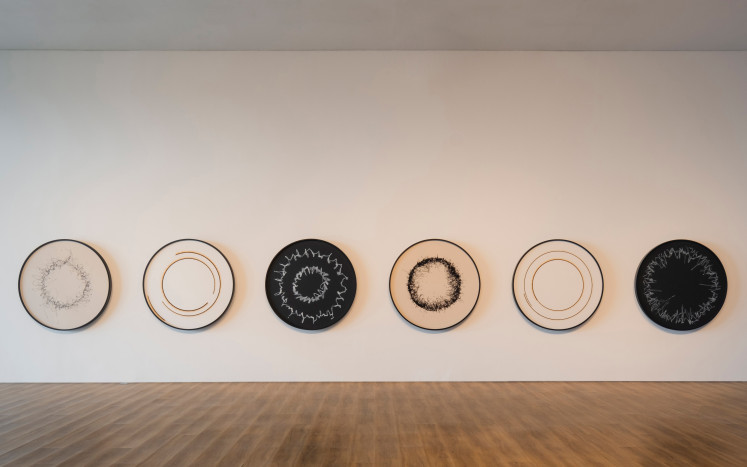Popular Reads
Top Results
Can't find what you're looking for?
View all search resultsPopular Reads
Top Results
Can't find what you're looking for?
View all search results'Pay attention to detail' and other writing tips from Leila S. Chudori
Having been a writer for a long time, Leila has so many practical fiction writing tips that she would like to share with aspiring young writers.
Change text size
Gift Premium Articles
to Anyone
Senior Indonesian journalist and author Leila S. Chudori, born in 1962, began writing at an early age.
Her experience as a writer can be traced back to when she was writing short stories for children’s magazines Si Kuncung, Kawanku and Hai when she was 12.
As an adult, she joined newsweekly magazine Tempo as a journalist in 1989, then later penned a number of literary works, including two novels – Laut Bercerita (The Sea Speaks His Name, 2017) and Pulang (Homecoming, 2013) – and two short story collections – Nadira (2009) and Malam Terakhir (The Final Night, 1989), on the side.
Her two novels center on the 1965 communist purge and the tragedy leading up to the 1998 Reform Era, respectively. In 2012, her novel Pulang won the Khatulistiwa Literary Award (the name of the award changed in 2014 to the Kusala Sastra Khatulistiwa Award).
Having been a writer for a long time, Leila has so many practical fiction writing tips that she would like to share with aspiring young writers.
The Jakarta Post had a chance to sit down at a fiction writing workshop facilitated by Leila during the first anniversary of Comma Books, a division of the Kepustakaan Populer Gramedia publishing house, part of the Kompas Gramedia Group, in early December. Here are some of her suggestions on how to write.
Pay close attention to detail
When writers research their characters, they have to be observant of the little details of the real-life individuals on whom these characters are based on, according to Leila. “You have to pay attention to whether they like to socialize, talk a lot or are very efficient when using words,” Leila said. “Also, pay attention to the kind of music or food they like.”
According to Leila, one’s preference of music or food might seem trivial but oftentimes could spark conflicts – or symbolize conflicts – between different characters. “For instance, when someone gets mad with her older sister, instead of serving her older sister’s favorite nasi uduk (steamed rice cooked in coconut milk with side dishes), she opts to cook fried rice for her,” she said.
Read also: Leila S. Chudori’s evolving journey
Derive your individual characters from an aggregate of real-life individuals
If you copy and paste real-life individuals’ biographical details into your fictional characters, then you are not writing fiction – you are writing a memoir, according to Leila.
“Like when [the late novelist] NH Dini was asked whether the character Sri in her 1972 novel Pada Sebuah Kapal [Aboard a Ship] had been based on her own life, she said that while around 50 percent of the character was based on her personal experiences, the remaining percentage had been made up of so many different people she knew,” she explained, adding that writers could camouflage the true identities of their characters by altering their ethnic identities, family constellations and religious convictions.
Investigate how the characters’ formative years have shaped their psyche
According to Leila, when one writes about a person, the writer cannot turn a blind eye to how the character’s formative years, comprising childhood and adolescence, have shaped them as adults, as well as how their relationships with their family members have shaped their psyche.
“For instance, it’s almost impossible for an orphan to grow into a happy-go-lucky person as a young adult without questioning his or her origins. Therefore, as part of researching my works, I always talk to psychologists to understand how different family dynamics form a person,” she said, adding that she also asked psychologists how a person could come to terms and make peace with their difficult past as an adult.
Divide your story into three main parts
“People like Virginia Woolf or James Joyce, who could write without planning a plot line, jumping among different events in their prose, were exceptional geniuses,” Leila said. Therefore, she advised beginners to plan their novels or short stories in three parts, using a beginning, conflict and climax, and resolution.
“Keep in mind that you don’t have to tell the story in chronological order or end your story with a definite resolution,” she said, adding that, even with a plot that is shuffled, mapping out a three-part dramaturgy strategy would help to develop a strong story arc.
Read also: Check out Leila S. Chudori’s recommended reading list
Go analog, keep a notebook
As you collect information, whether by interviewing or observing people, write it down in your notebook, Leila said. “Some writers say that they keep all the details in their heads, but I don’t believe in that kind of nonsense. Unless you write it down, you tend to forget the information you have collected,” she explained. (kes)











